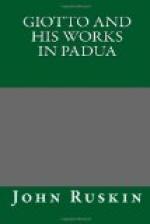I am not sure whether I shall do well or kindly in telling the reader anything about this beautiful design. Perhaps the less he knows about early art or early traditions, the more deeply he will feel its purity and truth; for there is scarcely an incident here, or anything in the manner of representing the incidents, which is not mentioned or justified in Scripture. The bold, hilly background reminds us that Bethlehem was in the hill-country of Judah. But it may seem to have two purposes besides this literal one: the first, that it increases the idea of exposure and loneliness in the birth of Christ; the second that the masses of the great hills, with the angels floating round them in the horizontal clouds, may in some sort represent to our thoughts the power and space of that heaven and earth whose Lord is being laid in the manger-cradle.
There is an exquisite truth and sweetness in the way the Virgin turns upon the couch, in order herself to assist in laying the Child down. Giotto is in this exactly faithful to the scriptural words: “She wrapped the Child in swaddling-clothes, and laid Him in a manger.” Joseph sits beneath in meditation; above, the angels, all exulting, and, as it were, confused with joy, flutter and circle in the air like birds,—three looking up to the Father’s throne with praise and thankfulness, one stooping to adore the Prince of Peace, one flying to tell the shepherds. There is something to me peculiarly affecting in this disorder of theirs; even angels, as it were, breaking their ranks with wonder, and not knowing how to utter their gladness and passion of praise. There is noticeable here, as in all works of this early time, a certain confidence in the way in which the angels trust to their wings, very characteristic of a period of bold and simple conception. Modern science has taught us that a wing cannot be anatomically joined to a shoulder; and in proportion as painters approach more and more to the scientific, as distinguished from the contemplative state of mind, they put the wings of their angels on more timidly, and dwell with greater emphasis upon the human form, and with less upon the wings, until these last become a species of decorative appendage,—a mere sign of an angel. But in Giotto’s time an angel was a complete creature, as much believed in as a bird; and the way in which it would or might cast itself into the air, and lean hither and thither upon its plumes, was as naturally apprehended as the manner of flight of a chough or a starling. Hence Dante’s simple and most exquisite synonym for angel, “Bird of God;” and hence also a variety and picturesqueness in the expression of the movements of the heavenly hierarchies by the earlier painters, ill replaced by the powers of foreshortening, and throwing naked limbs into fantastic positions, which appear in the cherubic groups of later times.




